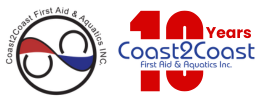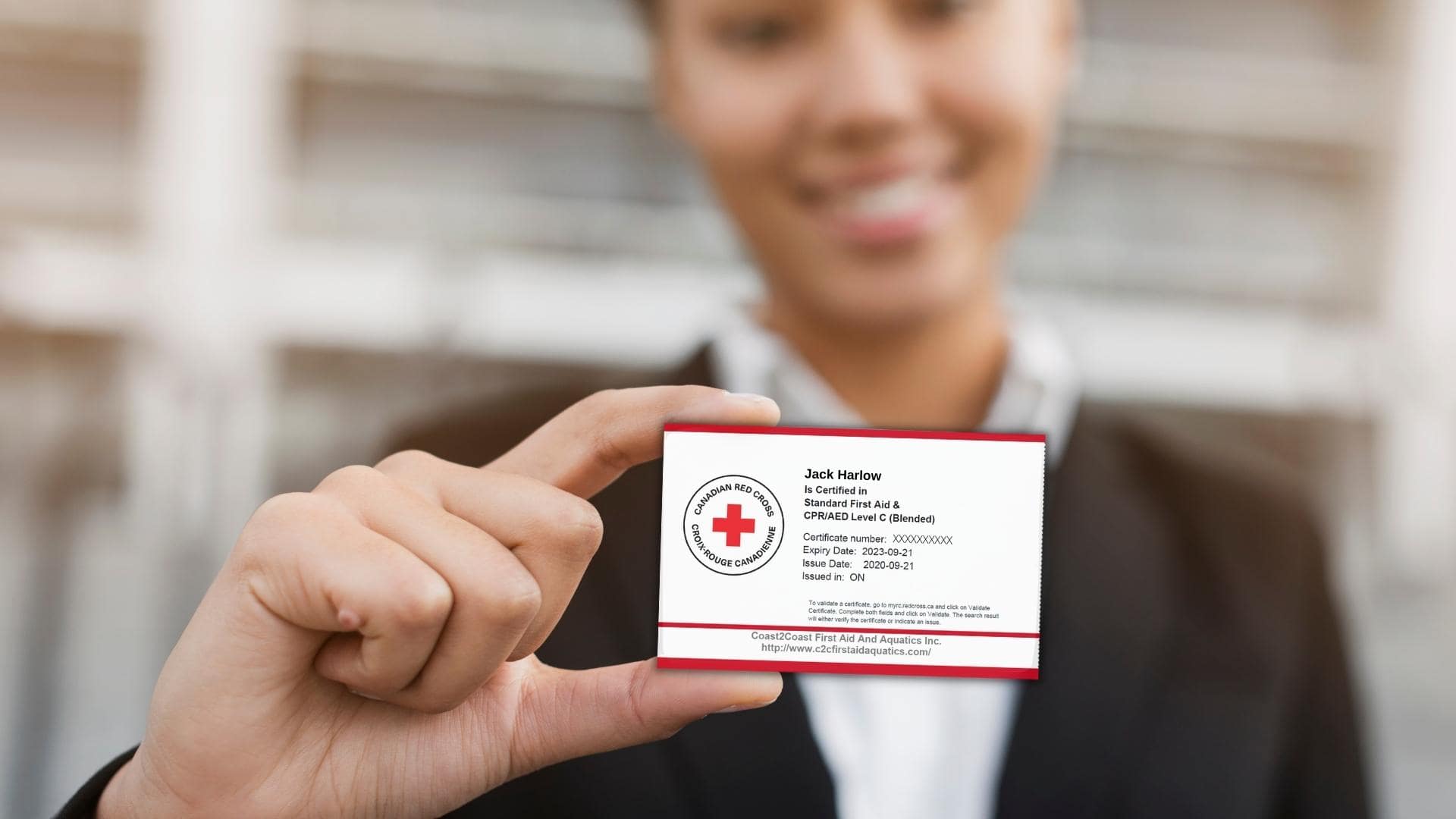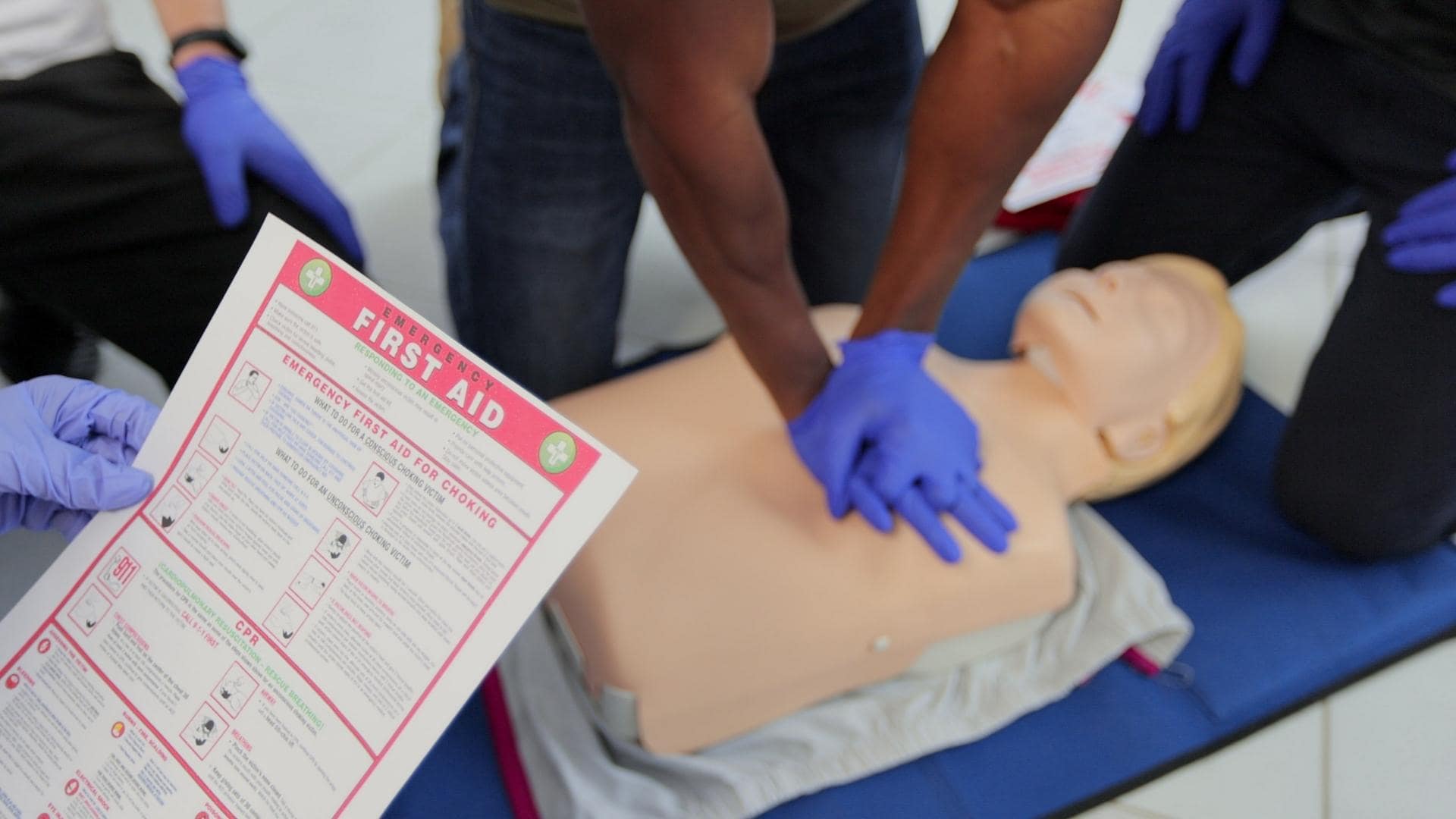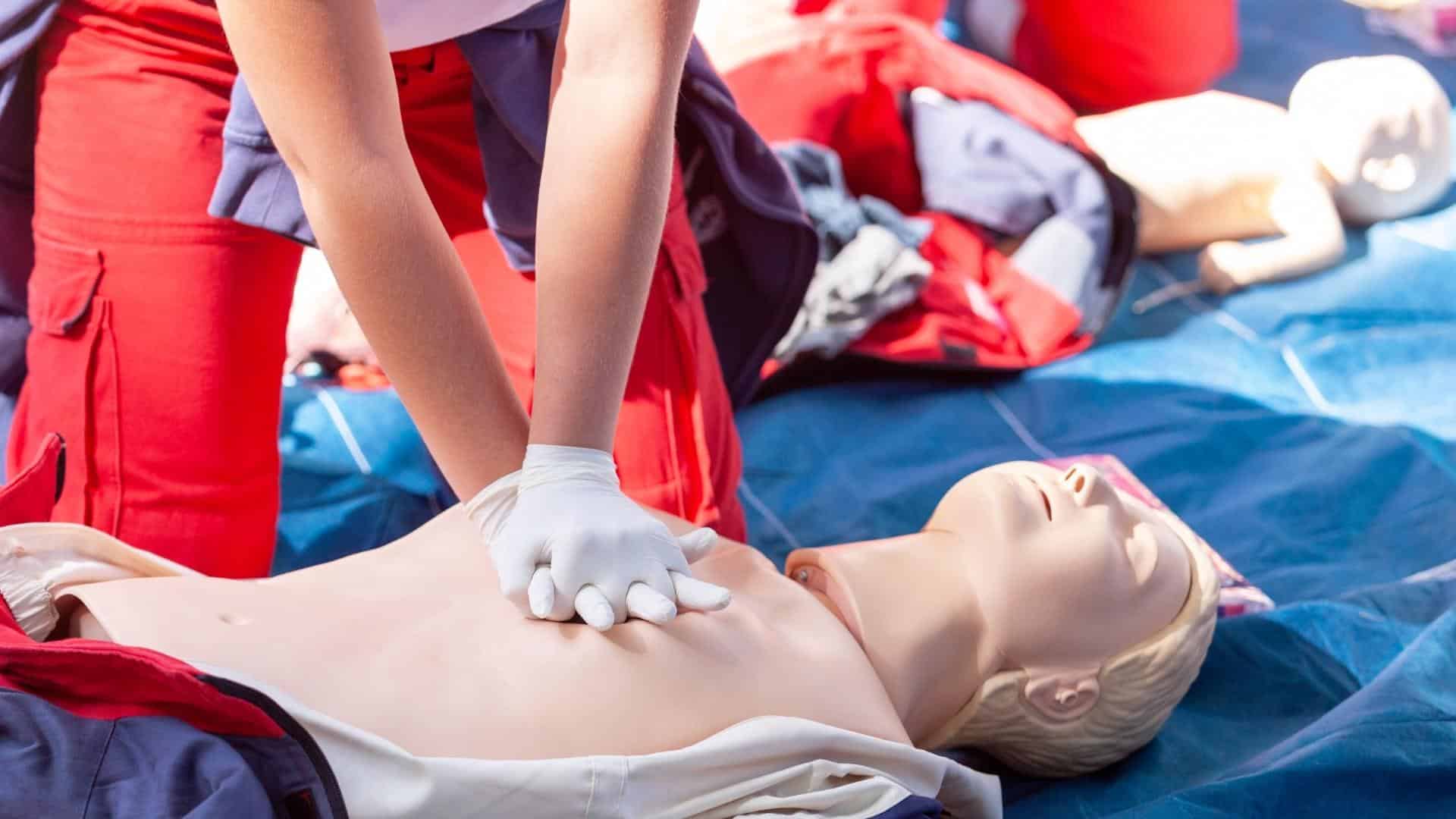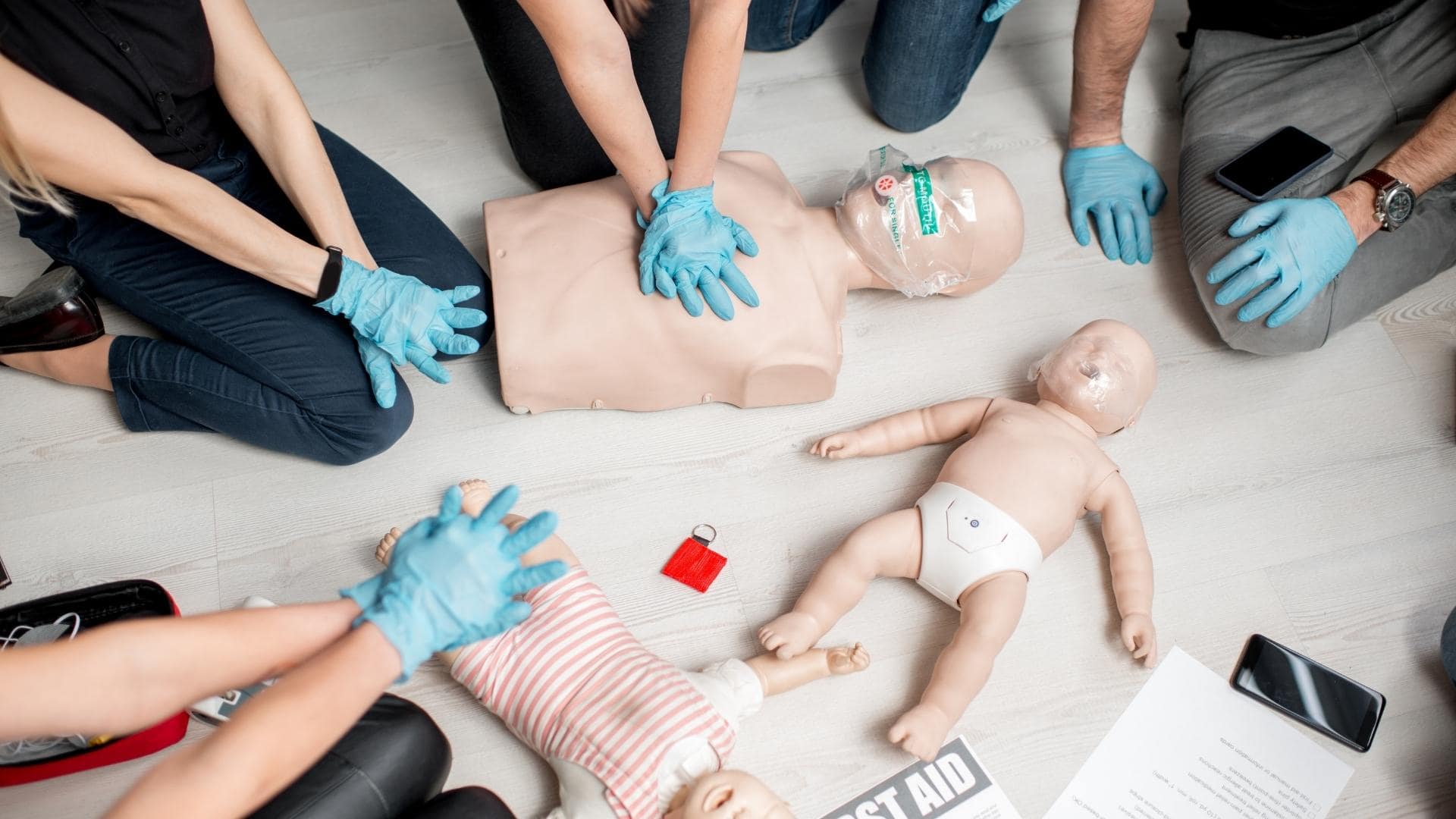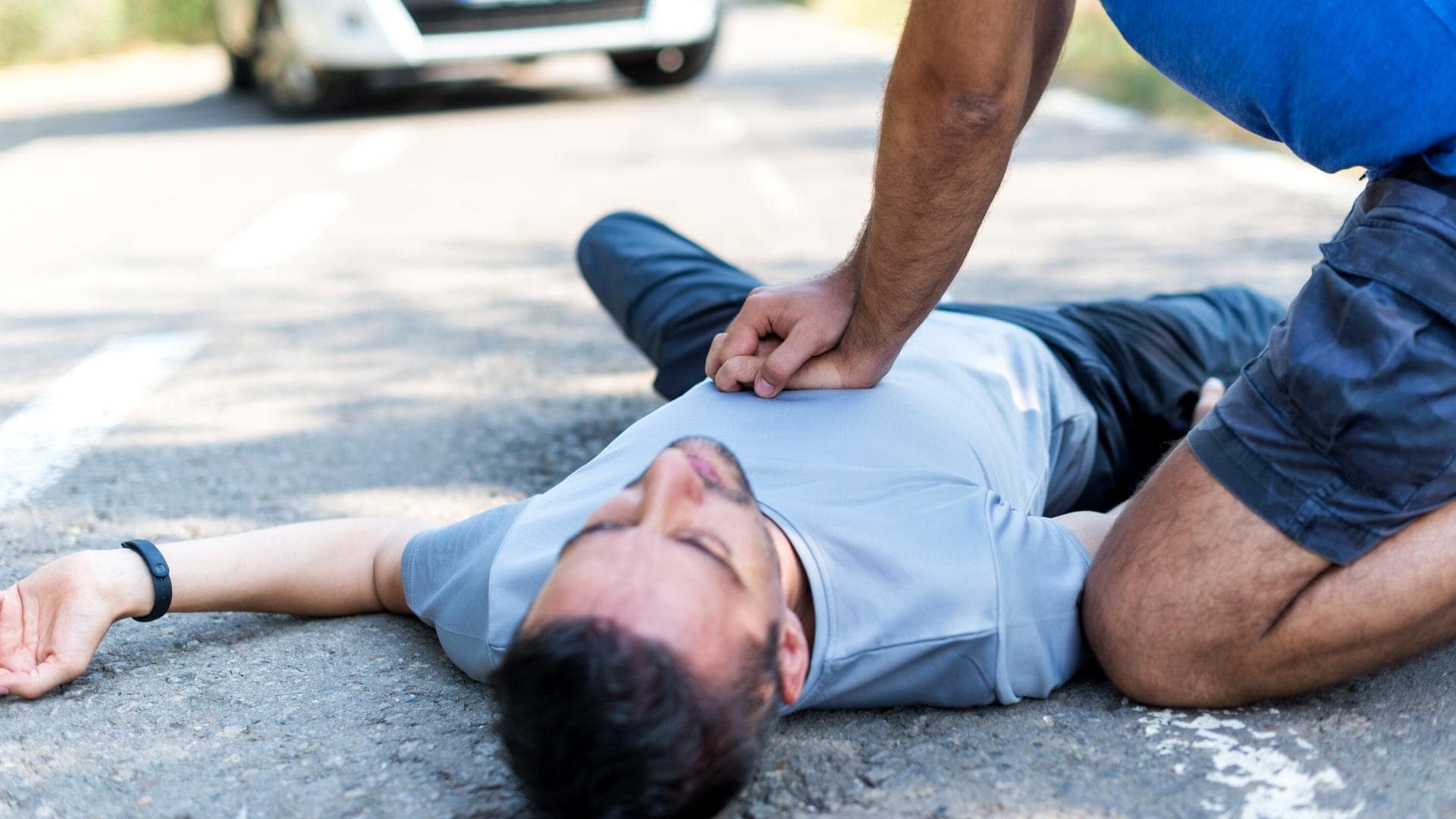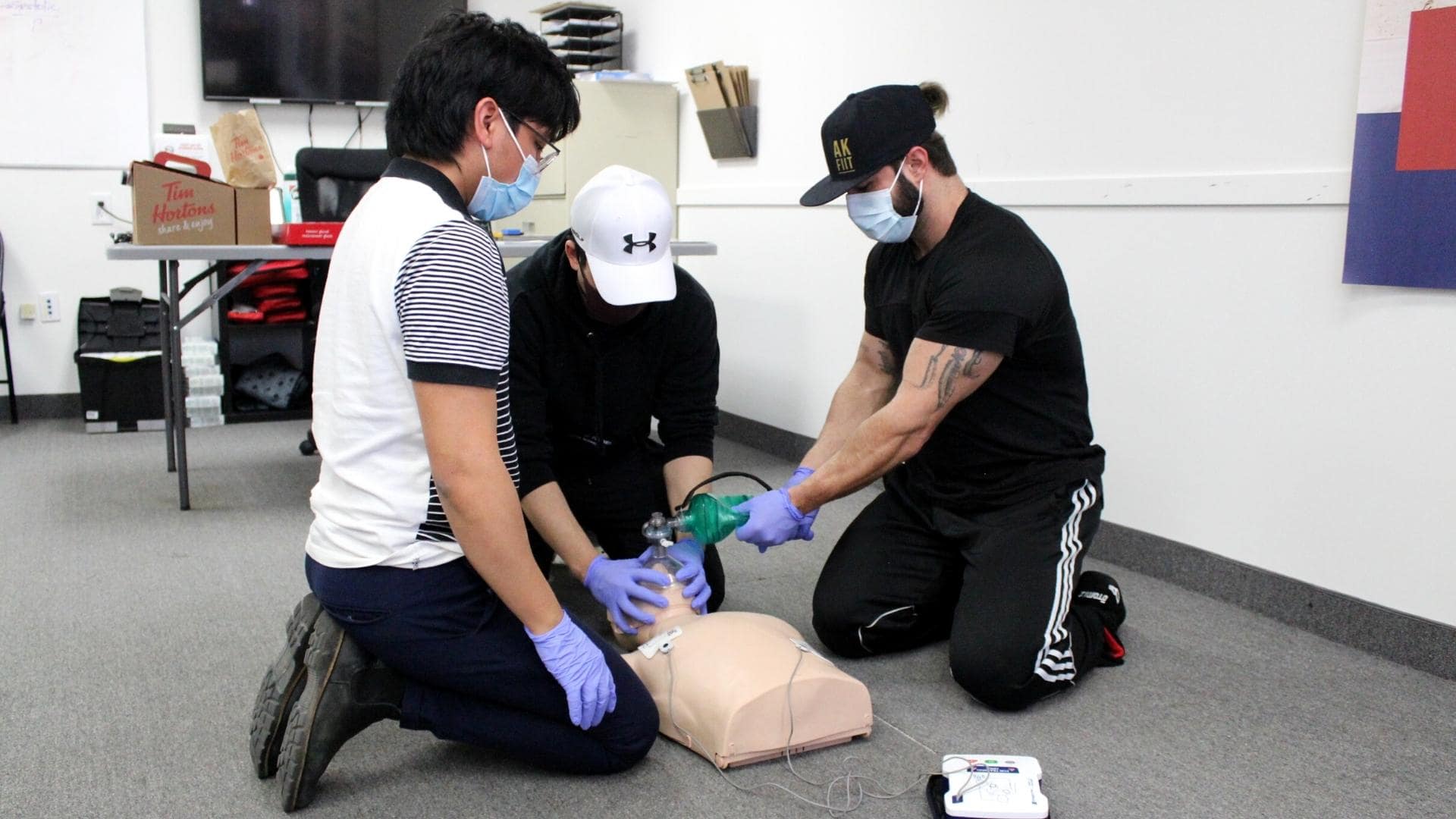Whichever level of First Aid and CPR training you need, on completing the course, you earn a Canadian Red Cross approved certificate. The skills and life-saving techniques you learn are invaluable, whether part of a work requirement or just to help others. When training at Coast2Coast, your First Aid certification is valid for three years.
Continue readingWhat to do when Stung by a Bee
Summer is about to begin in Ontario which means the bees are out! Bees play an important role in our world by pollinating our plants so we can eat. Without bees, we would not have the diversity of food we have today. Bees are a necessary insect in our world which is why it is so important to save them!
Unfortunately, many people are afraid of bees because they can sting. It is important to keep in mind that bees typically only sting if they are trying to protect themselves or their nest. Wasps, on the other hand, are more likely to sting and are often confused with bees.
Most people have no adverse reactions when stung by a bee, except for the initial stinging, pain, and redness. However, anyone allergic to bee stings can suffer severe symptoms from the allergic reaction. Multiple bee stings or an allergic reaction constitute a medical emergency, requiring an immediate medical response. In this blog, we will discuss what to do when stung by a bee.
Learn How to Take Care of a Bee Sting
Why bee stings cause allergic reactions
Bee stingers are barbed, and when they sting, it is usually left behind in the skin. From the moment a person is stung, the sting releases venom into the skin for up to a minute. The pain and swelling people feel are caused by the proteins in the poison. Some people are also allergic to hornets, wasps, yellow jackets, and it’s always good to run tests to determine what allergies a person has, helping to prevent placing them at risk if stung.
In some people, this venom triggers a severe reaction in their immune system, causing it to produce immunoglobulin E (IgE). IgE is an antibody used by the body to fight viruses and parasites, and when released in response to the sting, allergic reactions like swelling, hives, and breathing problems.
Sometimes, reactions to a bee’s sting can differ. Therefore, it’s best to look out for the reaction signs to the sting.

How to treat bee stings
Treatment for bee stings depends on the severity of the reaction. After a bee sting, a person should calmly walk away from the area to avoid another sting. If the bee’s stinger is in the skin, the best way to remove it is to scrape it out, but never use a tweezer because this pushes more venom into the area.
Mild to moderate reaction
If the bee’s stinger is in the skin, the best way to remove it is to scrape it away with a plastic card (such as a credit card). Next, wash the sting area with clean water before applying a cold pack. The cold pack will control swelling. Be careful not to freeze the skin, though. Place a cloth between the affected area and cold pack.
Painkillers can relieve the pain, and an antihistamine reduces itchiness and inflammation. These symptoms should only last a few days. Scratching the area can make the itching and swelling worse and increase the risk of infecting the sting area. Continue monitoring the sting for allergic reactions or anaphylaxis.
Severe reaction
In most cases, reactions of the immune system go unnoticed as the body defends against antigens. However, when there is a severe or anaphylactic shock, the immune system has an explosive reaction. Typically, anaphylaxis will begin within a few minutes of the sting or up to 30 minutes. Rarely will you suffer from anaphylaxis hours later.
In a severe allergic reaction (anaphylaxis), an epinephrine injection (adrenaline) helps reduce the severity. Bee stings can sometimes cause cardiac arrest within minutes in those allergic to them. Emergency responders will often administer oxygen, and once at the hospital, doctors may also administer intravenous fluids.
The symptoms of anaphylaxis include skin reactions, constricted airways resulting in breathing difficulties, nausea, dizziness, and wheezing. People with known bee allergies usually carry an EpiPen (an epinephrine injection device) and use it immediately after a sting.
Most people can administer the EpiPen injection themselves on the outer thigh, even through clothing if needed. If they cannot, in the absence of a first responder, anyone with the proper training can help them to administer the adrenaline to help save a life in an emergency involving an allergic reaction.
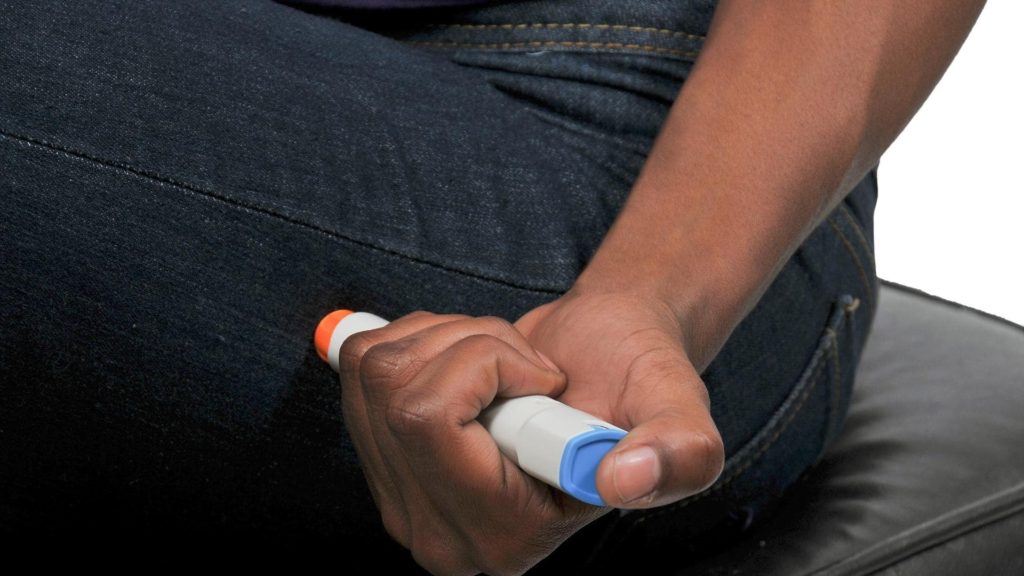
How to use an EpiPen
- Remove the safety cap by pulling straight
- Hold the epipen (orange side) against the middle third of the person’s outer thigh
- Push the epipen until you hear a click
- Remove the epipen and be cautious of an exposed needle
- Place the epipen into a container for the victim to bring to the hospital
- Ask the victim to rest until EMS arrives
- Rub site of injection for 30 sections (this helps with absorption)
- If the person is not feeling better within five minutes, you may inject a second dose (if available) into the other leg
People can suffer from an epinephrine overdose, so never administer more than two doses after each other. The signs of an overdose are difficulty breathing and irregular heartbeat.
After anaphylaxis, the person needs medical attention and should be cautious for at least 48 hours. They must also remember to get their new EpiPen since they can never leave home without it.
First Aid Training
Bee venom and other poisons are a real danger. First Aid training can help protect you and others by knowing what to do when faced with cases like these, whether the symptoms are mild or severe.
Our Standard First Aid training at Coast2Coast encompasses the training required to help in several emergencies, including those involving bee stings. Complete your training in an Online Blended format! Learn theory online prior to attending a one-day in-class training session. Select your area and register today.
Register for First Aid & CPR Training
Benefits of Private First Aid Training
Understanding how to provide proper first aid or CPR to an injured or unconsious person is important. Accidents can happen at any time which is why we should be prepared. A great way to learn these life-saving skills is to complete a First Aid & CPR training course.
Did you know that many professions require their employees to be first aid and CPR certified? That’s right! Everyone from nurses to office staff may be required to complete a First Aid & CPR training course. In Ontario, many companies are covered by the Workplace Safety and Insurance Act (WSIB). These companies must follow Regulation 1101 regarding first aid training and safety requirements.
One of our goals at Coast2Coast First Aid & Aquatics is to provide everyone with some form of First Aid and CPR training, ensuring they are confident enough to assist in an emergency.
Do your employees need to complete first aid training? At Coast2Coast, we offer Private First Aid training courses for groups of eight participants or more. There are many benefits of Private First Aid training compared to public courses. Let’s discuss more below!
What is Private Training?
As a Canadian Red Cross training partner, we are dedicated to provide several WSIB-approved First Aid and CPR courses. Most people do the training in their own time by attending a public course. However, we also provide Private First Aid training. With Private training, we take care of everything for your group!
At Coast2Coast, Private Training is a way for groups of eight or more participants to get trained together. There are many benefits to Private First Aid training such as certifying many employees at once, convenient scheduling, choice of training location/time, amazing discounts and more!
Arranging a Private First Aid training is simple. All you need to do is fill out a form on our website then one of our Private Training specialists will contact you. Once the details of your training are determined, we will finalize your training by booking one of our experienced Canadian Red Cross instructors.
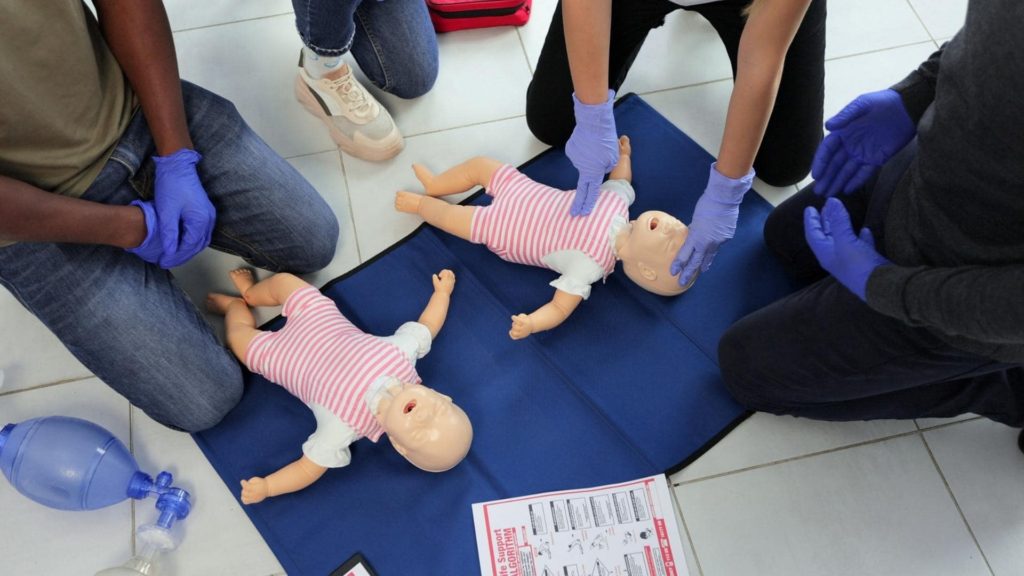
Our highly-trained instructors provide Private First Aid & CPR/AED training to groups of people at their chosen location. If your school, business, home, etc., is unsuitable for the training, we host the training at any of our facilities across Ontario. Clients can choose from several types of training levels, depending on their First Aid requirements. These include:
- CPR/AED Level A/C
- Emergency First Aid & CPR/AED Level C
- Standard First Aid & CPR/AED Level C
- Marine Basic First Aid
- Basic Life Support (BLS-HCP)
- Professional Responder programs (e.g. First Responder or Emergency Medical Responder)
- Youth programs (e.g. Babysitting or Stay Safe)
- And more!
On completion, the candidates in the Private First Aid training course receive a WSIB-approved certificate once their invoice has been cleared. First Aid and CPR certificates are valid for three years, and Basic Life Support certificates for one year.
Who Needs Private Training?
Any group of people, whether they are scholars, teachers, employees, medical professionals, friends, or family members wanting to complete a First Aid & CPR or Basic Life Support course, are the perfect candidates for Private First Aid training. Most often, employers who need to certify more than eight employees register for Private First Aid & CPR training.
As mentioned before, many companies are required to train their employees in first aid under WSIB’s Regulation 1101. Private training makes it convenient for them to complete this. Although, Private training is not only helpful for companies; it’s also helpful for groups of friends, families and more!
No one can deny the importance of First Aid training. Many people put it off because they feel they don’t have the time, don’t know how to register for it or think they don’t need it. Private training solves this problem because just one person needs to organize the training for everyone. Then one of our professional instructors arrives at the given date and time to do the training.
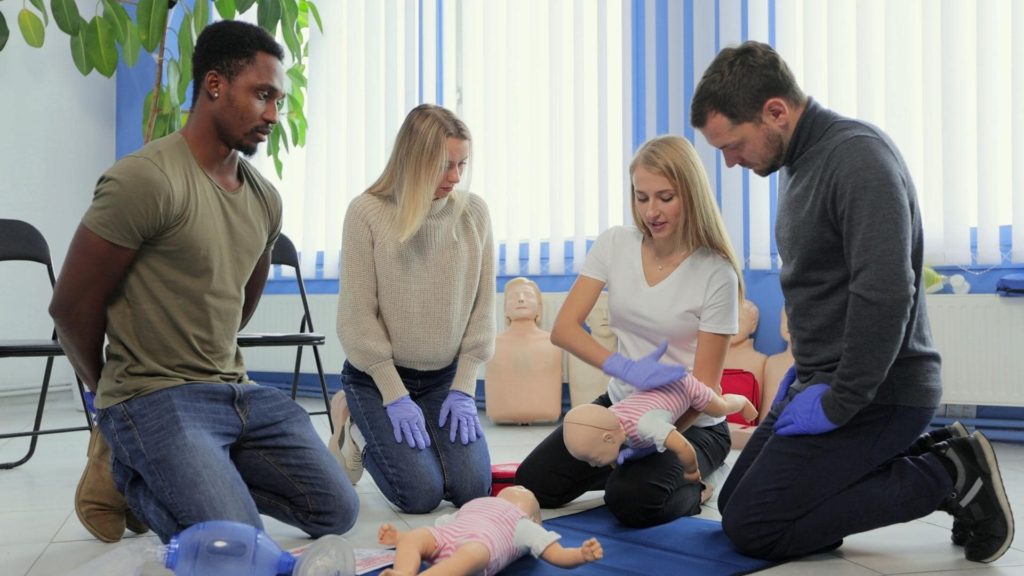
First aid training does more than just give you the confidence to help save lives. The person who provides first aid during an emergency offers the victim comfort and helps prevent the worsening of the victim’s situation. The more people within a group who have the training, the better it is for the whole.
Besides giving your group the confidence to care for others, private First Aid training encourages you all to live healthily and safely because of the knowledge and awareness you will learn from the instructor.
Empower Your Team with First Aid and CPR Training!
What are the Benefits of Private First Aid Training?
There are several benefits of Private First Aid Training:
- It saves time because everyone can take the course together, instead of taking time off separately.
- Everyone is simultaneously prepared to face any emergencies.
- Coast2Coast has fantastic offers and discounts for private training groups.
- Convenience of having an instructor come to you for the training on the day, time, and place that suits the whole group.
- Booking the private training is a simple process. Just fill in the form, providing the number of participants, type of course, and level, and one of our customer service representatives will contact you within 24 hours.
- All participants will receive a WSIB-approved certificate through the Canadian Red Cross.
Contact us at Coast2Coast by phone or email if you have any questions regarding Private First Aid & CPR/AED training courses.
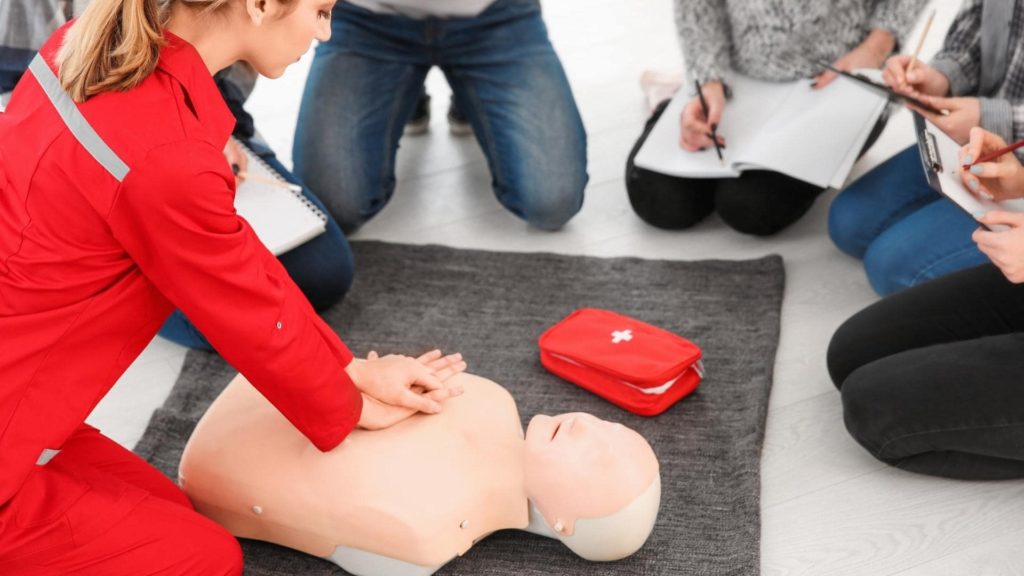
How to Register for Private Training
Register for Private First Aid Training today and ensure your fellow colleagues, family and friends get the confidence required to save others. The knowledge from the training is invaluable to everyone, helping you become aware of better assessing your surroundings and any situations that may arise. The training gives you the required confidence to help save and rescue any person who needs immediate help.
The Private Group Request Form is the quickest way to register for Private First Aid Training with Coast2Coast. Once the details are submitted, someone from our office will contact you within 24 hours. Together you can organize the training at a convenient day, time, and place for your private group training. Private training is available in Western Ontario, Eastern Ontario, and the Greater Toronto Area.
We hope you now understand all of the benefits of Private First Aid training!
Register for First Aid Training
Register today for a First Aid Training course and learn how to deal with emergencies and keep your loved ones safe! Check out our facilities and book your spot now.
Why Are Defibrillators Important?
Defibrillators or Automated External Defibrillators (AEDs) are devices that deliver a life-saving shock to someone suffering from cardiac arrest. The electric shock from the defibrillator passes through the chest wall to the heart, often giving a person in cardiac arrest a chance to survive.
Continue readingWhy is First Aid and CPR Recertification Important?
Healthcare professionals learn CPR, First Aid, and Basic Life Support training to help save people in health and other emergencies. However, CPR and First Aid training courses are also compulsory in different places of employment. Many citizens also learn these skills in their private capacity to offer their assistance whenever and wherever required.
Once you have completed your training in any of these lifesaving disciplines, you receive a certificate that proves your skills. Depending on the training, the certificate’s validity has an expiration date, and it is essential to keep the certificate up-to-date by taking the recertification training.
All these first response disciplines, whether to assist someone with a cut, bruise, cardiac arrest, anaphylaxis, choking, drowning, etc., are based on having the skills required to apply the techniques to help the person until professional help arrives.
We are an aging society, and the generation of Baby Boomers is now increasingly reaching the age where they may require medical assistance. The risk of exposure to viruses, infections, and environmental illnesses has also increased in recent years. First Aid and CPR are essential for helping an unconscious person or someone with an injury.
Using the proper techniques can save a life and improve the person’s chances of recovery. CPR and First Aid training is inexpensive and requires just a few hours, ensuring that you have the skills to help in any situation.
However, once you complete the training, you must consider that retraining and recertification are essential to keeping your skills refreshed. Workplaces and school programs often require employees and students to maintain valid certificates. Regular certificate updates benefit you because you retain the confidence to practice your lifesaving skills while also learning any new developments and techniques to save lives.
Workplace Requirements and First Aid
According to WSIB Ontario, First Aid training requirements differ in the workplace. These requirements include the number of people and type of First Aid training required and depend on several conditions. These include the number of shifts, people per shift, and the kind of business activity.
If a company does not use dangerous equipment or chemicals, the required number of employees usually take only Emergency First Aid training. Other companies must provide Standard First Aid training to the prescribed number of employees per shift if they work under more dangerous conditions.
Generally, if less than five employees work per shift, one employee per shift requires valid Emergency First Aid & CPR/AED Level C training and certification. For companies with more than five employees per shift, at least one employee must have a valid Standard First Aid & CPR/AED Level C certificate.
At some workplaces, the requirements are annual recertification, even if the certificate is valid for three years.
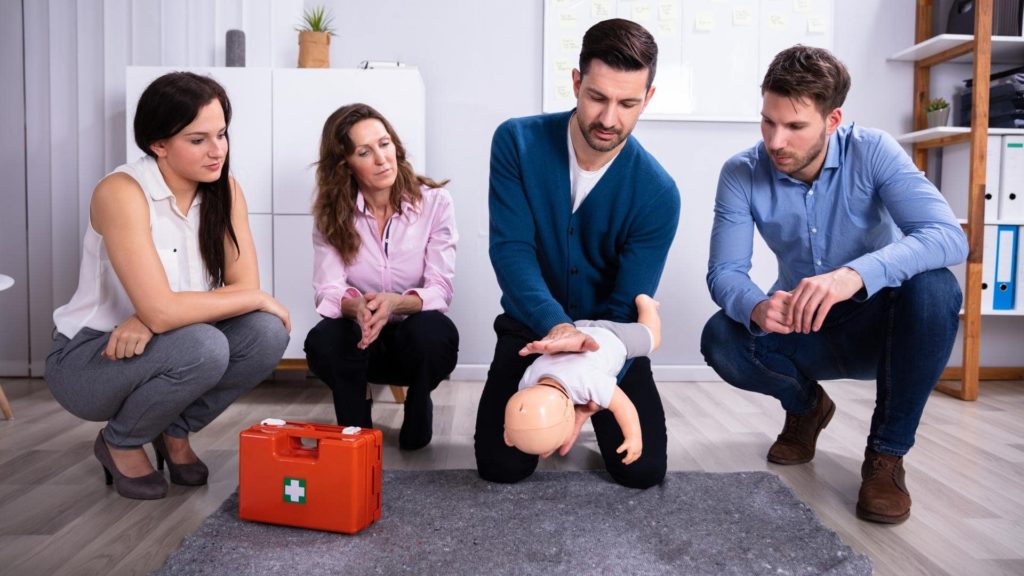
Stay Certified, Stay Prepared!
Renew your skills with our recertification courses at Coast2Coast! Keep your knowledge up to date and ensure you’re ready to respond in emergencies. Our expert instructors will guide you through the latest techniques and best practices.
Certificate Validity
Don’t forget the validity period of your First Aid, CPR, or Basic Life Support certification, especially if the certificate is a requirement under Ontario’s Regulation 1101 for your workplace.
CPR Training
CPR or cardiopulmonary training does not include any first aid training. The various levels of CPR training teach candidates how to recognize and respond to breathing emergencies like cardiac arrest, choking, drowning, etc. One of the major learnings would be the use of an Automated External Defibrillator (AED). CPR certificates are valid for three years, but can be recertified multiple times regardless. You need to retake the training and receive a new certificate before the old one expires.
First Aid Certificate Validity
Our Canadian Red Cross Emergency and Standard First Aid & CPR/AED certificates issued by Coast2Coast are valid for three years.
Standard First Aid & CPR/AED Recertification – Standard First Aid & CPR/AED recertification training must be completed before the certificate expires; otherwise, it is invalid. Once you complete the one-day renewal course, your certificate indicates the recertification. After the expiry of the Standard First Aid & CPR/AED recertification, you must complete the full training course again. Training must be alternated between a full course and the Recertification course.
Emergency First Aid & CPR/AED – According to WSIB in Ontario, Emergency First Aid & CPR/AED Level C courses can not be recertified. Before the expiry of this certificate, you need to register for the full training course. The online blended format is an ideal training, allowing you to complete half the training online followed by a 5-hour in-class section.
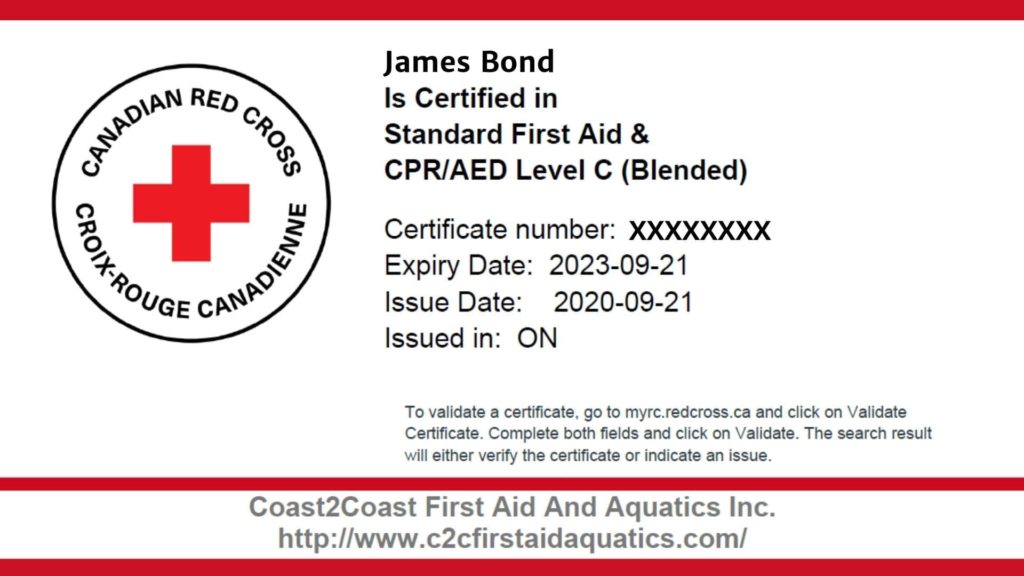
Basic Life Support Training
Basic Life Support is the intensive training required by people working in healthcare and rescue services. BLS certificates are only valid for one year. Full training is required each time because of the ever-changing duties of these professionals who usually work in fast-paced and demanding environments.
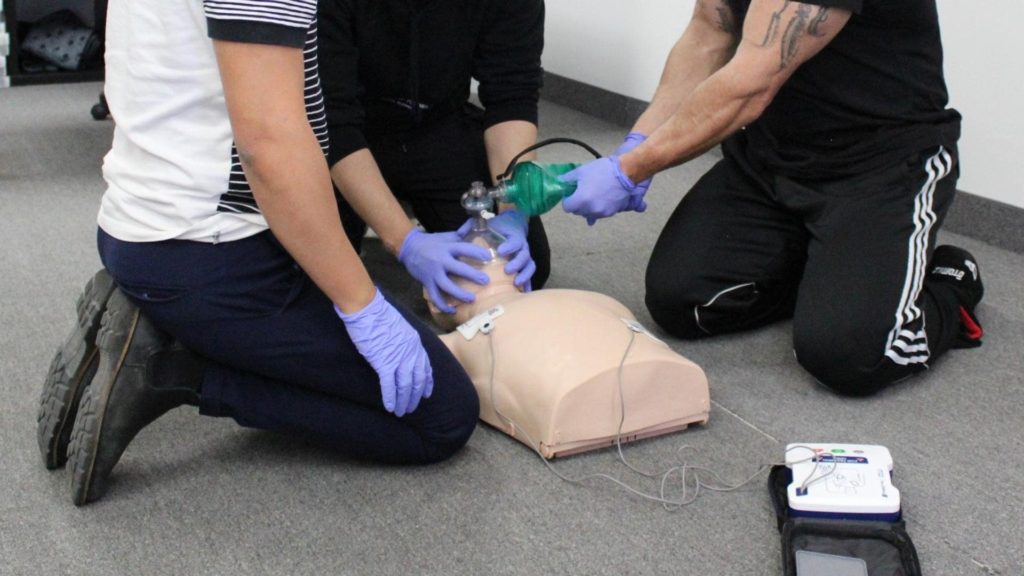
Coast2Coast First Aid & CPR Recertification Courses
Remember, if your Standard First Aid Certificate is about to expire, you need to complete the recertification training before to ensure its validity. All other certificates require you to do the training again. Whatever your CPR and First Aid certification needs, Coast2Coast offers various recertification courses throughout the day to best fit your schedule. Register for one of our Recertification courses from one of our 18 locations all over Ontario.
Register for First Aid Training
Register today for a First Aid training course and learn how to deal with emergencies and keep your loved ones safe! Check out our facilities and book your spot now.
Do I Need First Aid and CPR Training?
Anyone faced with an emergency situation can benefit from First Aid and CPR training because they may be able to save someone’s life. According to statistics, CPR can better the chances of survival from an out-of-hospital cardiac arrest if administered immediately as most cases of cardiac arrest happen in the home.
If you’re wondering, “do I need first aid and CPR training?”, we will discuss the benefits, requirements and how to complete a training course.
Benefits of First Aid Training
First Aid training has several benefits because you acquire the knowledge and skills to provide the appropriate care in most emergency situations calmly and confidently.
The skills learned during First Aid training include detecting a stroke, heart attack, anaphylaxis, dealing with injuries, cardiac arrest and more. It also teaches you how to correctly perform CPR when needed. During the training, you will practice treating wounds, burns, choking, drowning, and suffocation in victims.
The skills learned are essential for parents, caregivers, and job seekers in almost all fields. Research also shows that children as young as nine years old can learn the correct administration of CPR. It may be beneficial for you to enroll your children in a Babysitting or Stay Safe training course!
There are two levels of First Aid: Emergency and Standard. We recommend that students complete Standard First Aid because it provides more information and skills compared to Emergency First Aid.

Who Needs First Aid Training?
Most commonly, medical professionals are the ones who require First Aid & CPR training. This group includes doctors, nurses, medical assistants, paramedics, and other rescue workers like lifeguards and ski patrols.
In addition to medical professionals, all childcare providers, law enforcement, firefighters, sports coaches, construction workers, correctional services staff, flight attendants, security guards, electricians and more require first aid & CPR training.
All businesses must also ensure that the required number of workers have First Aid Certification, whether they are shop assistants, factory workers, secretaries, servers, managers, and volunteers. According to the Workplace Safety and Insurance Act, businesses covered by their fund must have trained personnel and first aid equipment on their premises.
The training must come from a WSIB-approved First Aid provider, and the appropriate number of staff must complete the First Aid course and receive certification according to the guidelines.
Register for First Aid Training
Register today for a First Aid training course and learn how to deal with emergencies and keep your loved ones safe! Check out our facilities and book your spot now.
Required First Aid Training in the Workplace
Mandatory WSIB First Aid training depends on the number of people working per shift at any given time in the workplace.
In workplaces with five or fewer people working per shift, one or more people with an Emergency First Aid & CPR certificate must be present. In workplaces with more than six people working per shift, at least one person must have a Standard First Aid & CPR certificate.
Since all these employees mentioned above work with many people and often work under hazardous conditions, First Aid & CPR training allows them to recognize and assist in health or work-related emergencies.

Is First Aid and CPR Training Mandatory?
First Aid training is not always mandatory. Typically, school programs and workplaces are implementing these certifications, but not every school or business requires this training. Although, there are several reasons why you should get certified regardless of your profession.
Recognizing emergencies and saving lives requires knowledge, skills, and confidence. First Aid training provides these, allowing you to face any situation from choking, accidents caused by the use of dangerous equipment, and even recognizing the signs of cardiac arrest or anaphylaxis. You learn in which order CPR and other techniques are applied, often making the difference between temporary or long-term side effects.
Besides saving a life, First Aid training teaches you to ease the pain and discomfort caused by falls and fever, even if the patient does not need to go to the hospital.
Some situations where basic first aid care is not applied immediately may lead to the victim’s condition deteriorating rapidly. This weakens their chance of survival until emergency medical care (EMS) arrives. Your First Aid training can save valuable time by helping the victim, explaining the situation to emergency services, and their current condition.
Perhaps First Aid training is not mandatory, but it helps you become a valuable link in the chain of another person’s survival in an emergency.
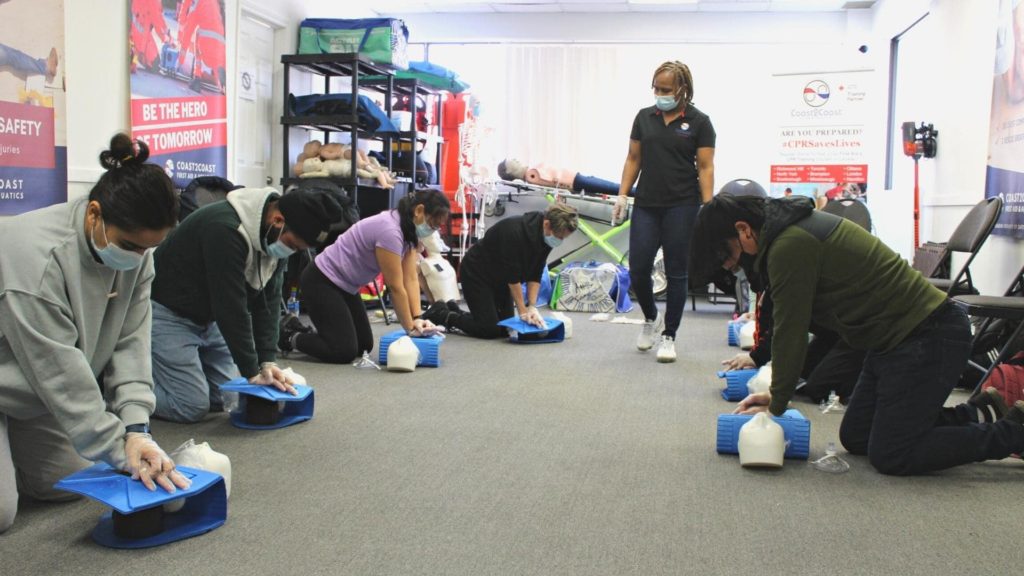
How to Complete First Aid Training
Whether you must get First Aid training for your work or just want to help others, completing First Aid training is far easier than most people think. The time required depends on the training necessary, but it won’t take more than two days for advanced training and one day for basic training.
Coast2Coast has several First Aid Course options to ensure that everyone has the correct training for their needs. Training may be done in the online blended method, allowing you to do the theoretical work in your own time at home before attending an in-person session. As a Canadian Red Cross training partner, Coast2Coast has experienced trainers and provides WSIB-approved certification.
If you thought you were too busy or didn’t know where to go for a First Aid course, Coast2Coast offers you training solutions at a time and place that suit you. You may complete your First Aid & CPR training course at one of our 18 locations across Ontario. If you have any questions about a training course, please do not hesitate to contact us.
Questions About Your Course?
Our team is ready to help you with your questions. Don’t hesitate and contact us today.
The Difference Between Security Guards and Private Investigators
The professions of a security guard and private investigator might sound similar, but there are some differences between the two occupations. Anyone wanting to work either one of the two in Canada requires a valid license. It’s important to learn the difference between these before deciding which training suits the career path you want to follow. Let’s discuss the difference between security guards and private investigators.
The Role of Security Guards
The primary responsibilities of security guards entail area observations for security breaches, managing any issues, reporting dangerous situations or suspicious behaviour and more. Security guards perform these duties to protect private property and the public. Security guards work in airports, condos, stores and shopping malls. Some also work as bodyguards.
Proper training is required to ensure security guards can recognize and handle situations until the appropriate authorities arrive to take over. Unlike private investigators who often work undercover, security guards work in the open, visibly showing their presence.
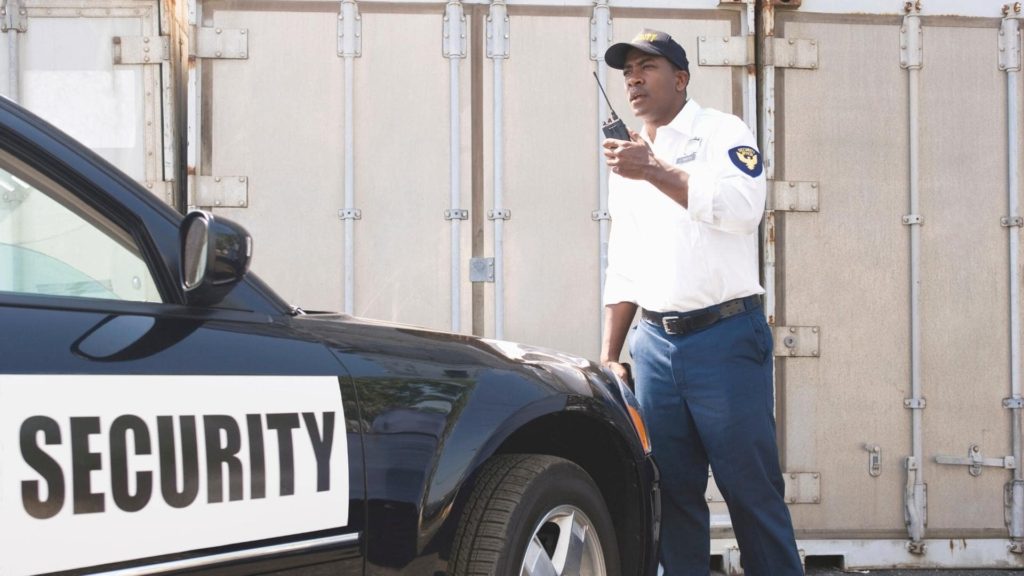
The Role of Private Investigators
Private investigators are typically employed by citizens, companies and attorneys to investigate the whereabouts or actions of people, issues regarding workplace health and safety, environmental incidents and more. There are various reasons why someone would want to hire a private investigator, including investigating fraud, theft, infidelity, disputes over child custody, and finding missing assets or a person.
To investigate, private investigators need to learn several investigative techniques and conduct research. These include internet searches, public databases, background checks, etc. Private investigators also use audio and video surveillance, take photographs and conduct personal observations.
The work that private investigators do still requires them to work within the law. As a private investigator, you must have a good understanding of the laws, be ethical and have great communication and listening skills.

Register for Security Licensing Course!
Take the first vital step towards an impactful career in security by registering now to obtain your Ontario security license, enabling you to play a pivotal role in maintaining safety and protection within your community.
Can You Be a Security Guard and Private Investigator?
Yes, you can become a security guard and private investigator by taking both courses and passing.
Dual License
Once you have passed the courses to become a security guard and a private investigator, you can apply for a dual license. With a dual license, you can work as a security guard or private investigator. Dual licenses help broaden your career possibilities and provide you with additional knowledge.
How to Become a Security Guard
Before applying for a license to become a security guard, you must complete a training course approved by a Ministry training partner. This online training course takes approximately 33.5 hours to complete, and you can do it in your own time. If you need help with any course sections, an instructor is available by email or phone.
On completing the course, you receive a Training Compliance Number (TCN) to book your Ministry test. The test consists of 60 multiple choice questions that must be answered within 75 minutes. Once you have passed the exam with a minimum of 62%, you can apply for your license at Service Ontario.

The license is valid for two years. Requirements for applying for a security guard license include that you must be 18 years and older, have a clean criminal record, be legally entitled to work in the country, and have mandatory First Aid training.
How to Become a Private Investigator
The mandatory course to become a Private Investigator in Ontario is about 50 hours. This online course covers a wide range of topics from criminal civil law to key principles of communication and interaction.
Online training allows you to complete the course at your own pace, but you also have access to the instructors if you need help. Once you pass the test, you receive your Training Compliance Number (TCN). With this number, you can schedule the exam at the Ministry, and on passing it, you can apply for an Ontario Private Investigator license. Private investigator licensing is valid for two years and is renewable two birthdays after issue.
Is Private Investigator Training Difficult?
Private investigator training is not too difficult, but in Canada, you need to get a license for the province you want to work. However, you must meet several requirements. These are:
- The minimum age is 18 years or older
- Eligible to work in Canada
- No criminal record
- Pass the government licensing course

Where to Complete Security Guard or Private Investigator Training?
Whether you want to become a security guard, private investigator, or combine the two and hold a dual license, Coast2Coast offers Ministry-approved training required to match your career needs. Our online training is available for both courses, ensuring your convenience whatever career path you choose to follow.
Do you want to be a Private Investigator?
Coast2Coast First Aid & Aquatics has recently partnered with a great security training company that offers various courses including Private Investigator training.
Best First Aid and CPR Training in Kitchener
Facing an emergency without First Aid training is daunting and leaves people feeling helpless. Many people in Kitchener put off First Aid training for various reasons, mainly that they don’t have time or don’t know where to take a course. Others believe that they don’t need training but don’t realize that some techniques, especially CPR, require specific training.
The level of First Aid training someone needs will depend on their personal circumstances and career. Someone looking after children or a sick relative may need a higher level of training than someone who wants to prepare for general emergencies.
People who work in educational facilities, community settings, sports training centers, and healthcare professionals typically require advanced levels of training. Standard First Aid prepares participants for common medical emergencies needed for these careers, including environmental crises.
First Aid is not mandatory in Canada, but everyone is encouraged to help others in everyday emergencies. Helping each other is a moral obligation, and knowledge gives you confidence. Ready to find the best first aid and CPR training in Kitchener? Look no further!
New Training Facility in Kitchener
Coast2Coast has opened up a new training facility in Kitchener, making First Aid and CPR training more accessible than ever before. Several levels of First Aid and CPR training courses are available, including Emergency First Aid, Standard First Aid and Basic Life Support (BLS-HCP). Coast2Coast recommends everyone complete first aid and CPR training even if you do not require it for work or school programs.
Teaching times for First Aid and CPR training in Kitchener depend on the course level you choose. Our Online Blended training format is the most popular for Emergency First Aid and Standard First Aid because it saves time, allowing participants to complete the 4-8 hours of online learning (in their own time). The practical segment of the course has 5.5-8 hours of in-class training.
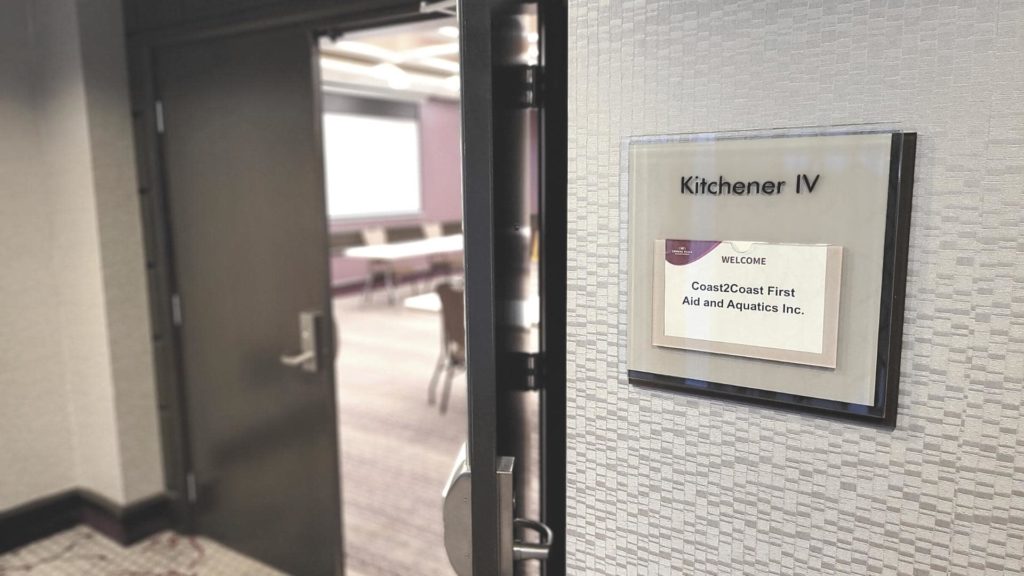
In-class training is an integral part of a first aid course because you learn the correct techniques firsthand from our experienced, Canadian Red Cross instructors. During this portion of your course, students will practice these techniques. Instructors are there to help you if you are struggling with any section of the course.
The in-class portion of our First Aid and CPR training in Kitchener starts at 9 AM. Once you complete the course and pass the multiple-choice exam, you will receive a WSIB-approved Canadian Red Cross certificate. All First Aid certification is valid for three years, after which you can recertify.
The in-class sections of First Aid & CPR require 100% attendance and a score of 75% or higher on the multiple-choice test.
Importance of First Aid & CPR
Since no one ever knows when an emergency will occur, First Aid training provides the confidence required to help save a life. Emergencies don’t always happen where first responders are available, so you might need to assist a loved one at home, a stranger on the road, or a colleague at work.
First aid training is not only for dealing with accidents. Depending on your course level, training may help you recognize illnesses, poisoning, cardiac arrest, and anaphylaxis. You also learn to call for emergency services, offering the correct assistance and comfort until professionals arrive.
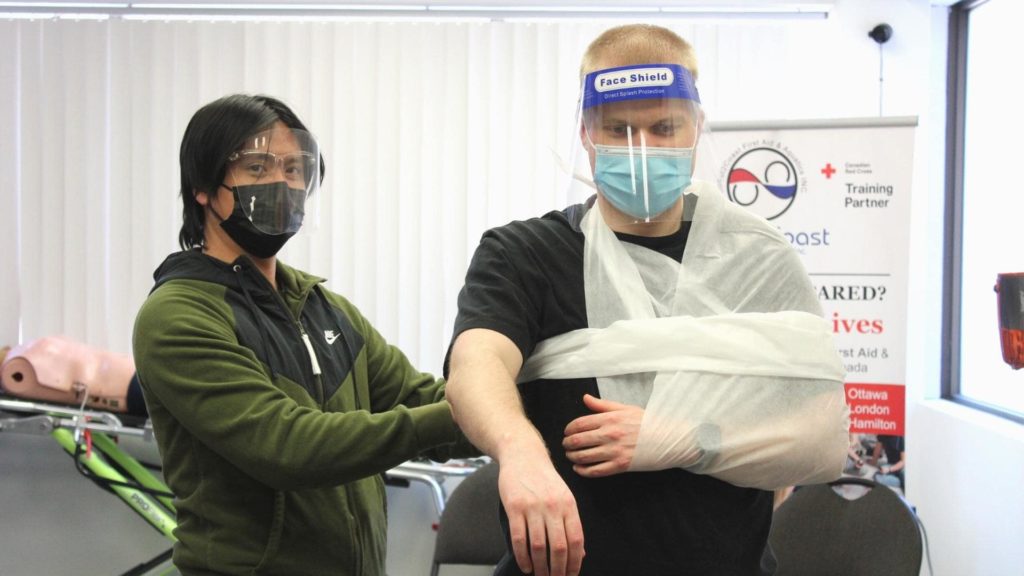
Get Trained in Kitchener!
Join our First Aid Training in Kitchener and equip yourself with vital life-saving skills. Our expert instructors provide hands-on training to prepare you for emergencies in any situation.
Being prepared to assist in any situation is the first thing you learn, but First Aid training prepares you to share your skills and become more aware of personal safety and health.
Some of the things you can expect to learn during Emergency First Aid & CPR training in Kitchener:
- The Red Cross
- First Aider’s Role Chain of Survival Behaviors
- Lowering Risk of Infection
- Check, Call, Care
- Placing Someone in the Recovery Position
- Shock
- Choking in Adults (Level C Includes Choking for Children and Infants)
- Assisting with Medication
- Angina and Heart Attack Stroke CPR/AED in Adults (Level C Training Includes Children and Infants)
- Compression-Only CPR
- Treating Life-threatening External Bleeding and Internal Bleeding
- General Wound Care
In Standard First Aid, the training includes environmental emergencies, head, neck, and spine injuries, poisons, and other medical emergencies.
How to Register for First Aid & CPR in Kitchener
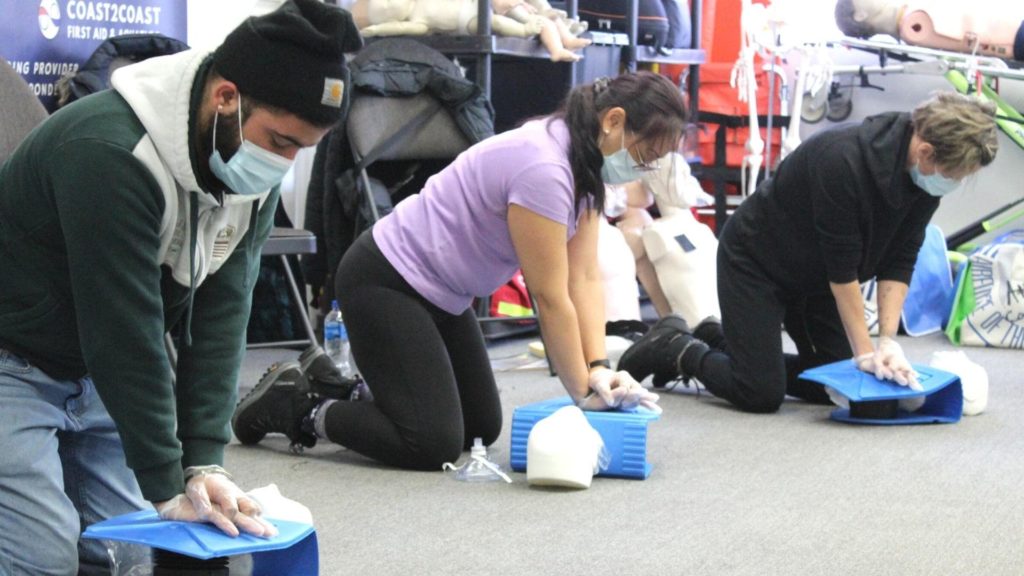
Registering for First Aid and CPR training in Kitchener is easier than you ever thought. Check out our training locations under the “Find a Training” section on our website’s menu. From there, you can select the location of your choice. Each location has a page where you may select the course type you are interested in. Choose the First Aid & CPR option to see our upcoming course dates. Click on Register Now to book, fill in the Registration Form, and Submit.
Register for First Aid Training
Register today for a First Aid Training course and learn how to deal with emergencies and keep your loved ones safe! Check out our facilities and book your spot now.
Why Do Healthcare Professionals Need BLS Certification?
Basic Life Support Certification is proof of completing the foundational BLS training. Participants of the BLS course learn the theoretical and hands-on skills required to ensure the best possible patient outcomes in breathing emergencies and cardiac arrest, particularly in fast-paced environments like hospitals and during emergencies. Healthcare professionals, first responders, rescuers, sports doctors, and dentists need BLS certification.
There are several ways Basic Life Support training can impact your career. Besides providing you with the latest life-saving protocols for breathing emergencies, advanced CPR training increases your confidence levels.
For those that are confused, there is a slight difference between BLS and HCP. Basic Life Support training was previously known as CPR-HCP. Certifications expired every three years. In April 2019, the Canadian government required healthcare professionals to update their training on an annual basis. Due to this change, the course is now called Basic Life Support and it provides students more information and skills required for their profession.
Continue reading to find out why healthcare professionals need BLS certification!
What is BLS?
Basic Life Support training provides healthcare professionals and first responders with the skills required to help unresponsive people during breathing emergencies, trauma, etc. The course includes CPR/AED training for all age groups and various other skills.
One of the most common conditions where BLS is required is cardiac arrest. Other cases where the patient is deprived of their vital oxygen supply include choking or drowning. Within a few minutes, a patient can suffer permanent brain damage from a lack of oxygen. In the absence of advanced equipment, BLS training allows healthcare professionals to maximize the chance of a possible outcome for the patient by administering resuscitation and chest compressions as a team.
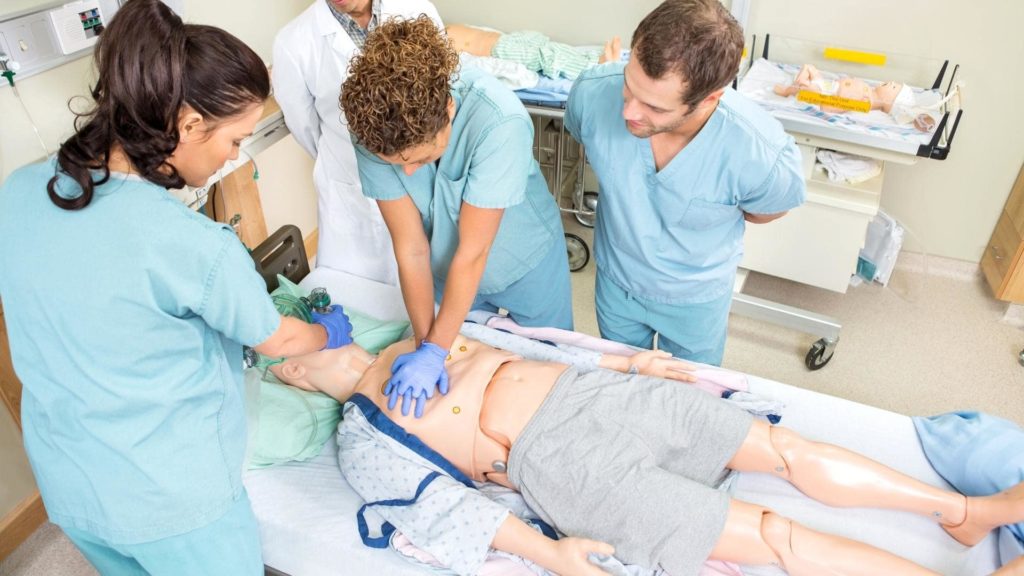
During the training, participants learn the correct order of CPR and the cycles of CPR.
Expect to learn the following skills in BLS:
- Advanced CPR algorithms (adults, children, and babies)
- Use of an automated external defibrillator (AED)
- Removing airway obstructions in children and adults
- Single and multi rescuer resuscitation
- Use of ventilation devices
- Anaphylaxis
- Trauma
- Opioid emergencies
- Six rights of medication and more!
BLS requires the correct sequence of chest compressions, airway, and breathing, in adults, children, and infants. These components contribute to blood flow and oxygen in life-threatening situations. During training, you learn about the chest compression rate, chest compression depth, chest recoil, and ventilation. You also learn how to perform this in the proper cycles.
Register for First Aid Training
The importance of BLS
Promptly administering advanced CPR can save a person’s life from cardiac or respiratory arrest. Recertifying annually keeps healthcare professionals updated with any new developments.
BLS training teaches students the proper way to administer the life-saving skills required by healthcare professionals and other related industries. These skills are vital for people who offer direct patient care. At Coast2Coast, we offer private/group training for healthcare industry teams; reach out to our customer service reps to find the best option for your needs.
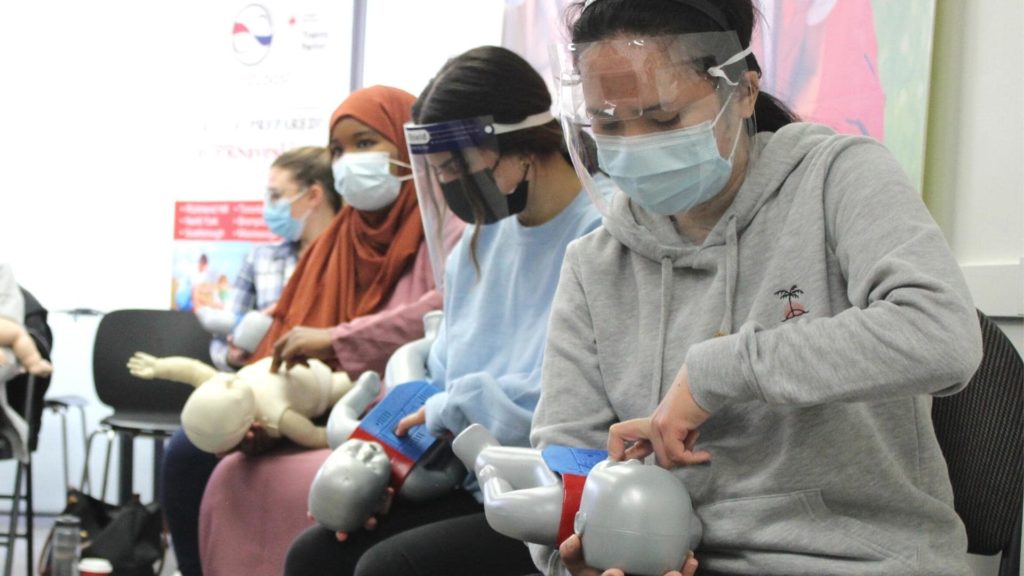
BLS Certification Validity
Basic Life Support certificates remain valid for one year after they are issued. In order to take our Renewal course, you must hold a BLS certificate. Annual retraining ensures that participants retain their confidence and skills. Besides the regular retraining, make sure to get your BLS certificate from an accredited provider such as Coast2Coast First Aid!
Coast2Coast BLS Programs
Coast2Coast has multiple programs to choose from, depending on your work requirements. These are Basic Life Support (HCP), Airway Management & Oxygen Therapy, and Accredited Heart and Stroke Basic Life Support. All the courses teach various life-saving skills, including recognizing cardiac arrest. Participants learn how to respond promptly and confidently, applying the elements of Basic Life Support.
BLS is a 4-hour training course available in morning, afternoon, and evening classes to ensure everyone finds a time slot that suits them. The Basic Life Support and Renewal courses have the same duration, but the Renewal option is offered at a lower rate. If you register for the Renewal, you must bring a copy of your current certificate to class to receive your discount.
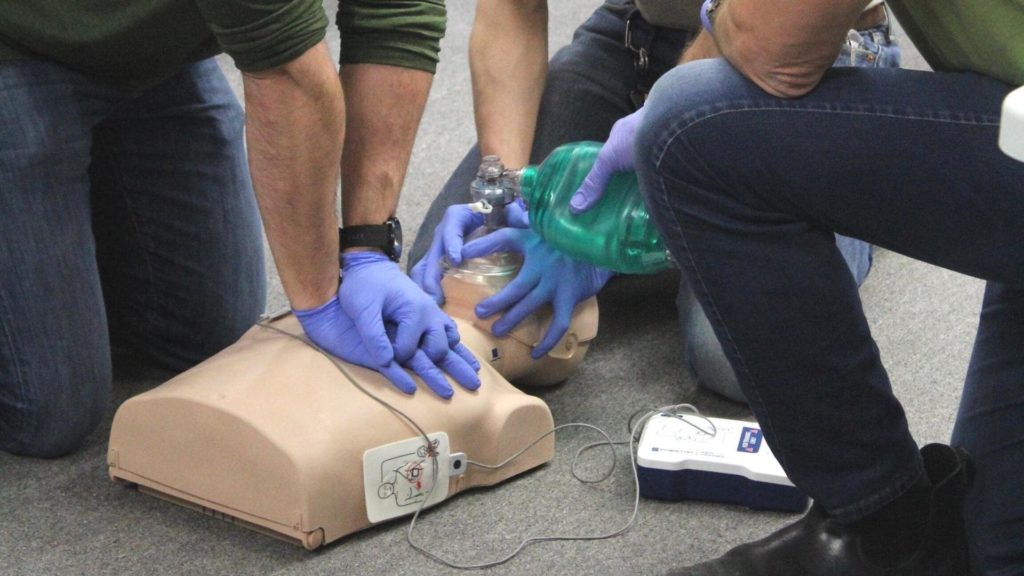
Airway Management & Oxygen Therapy is a two-hour intensive training course that provides the skills to offer supplemental oxygen and create an airway when needed. Students learn how to create oropharyngeal, nasopharyngeal, and supraglottic airways in patients. This training also covers the safe handling and assembling of equipment such as oxygen tanks. Oftentimes, this training is taken together with Basic Life Support training by healthcare professionals, first responders, and rescue workers.
Coast2Coast provides Canadian Red Cross Basic Life Support courses in the Greater Toronto Area, Western Ontario, and Eastern Ontario. Learn more about the locations, dates, and times of the various BLS courses HERE.
We hope you’ve learned why healthcare professionals need BLS certification!
Master the Essentials of Life Support!
Join our Basic Life Support (BLS) course and learn critical skills to save lives in emergencies. Our expert instructors will guide you through hands-on training and the latest techniques to help you respond effectively.
How to Prevent Environmental Illnesses
Exposure to the cold and extreme heat are the most common elements that cause environmental illnesses. In addition to these, there are also environmental poisons. The symptoms of environmental illnesses vary, depending on the chemical, pollution, allergen, toxin, virus, or climatic condition the victim is exposed to. Preventing environmental illnesses is not easy, but the faster people are removed from the danger and treated, the better.
Environmental hazards typically occur outdoors when people are exposed to extreme climatic conditions or poisons. Now, let’s learn how to prevent environmental illnesses!
What are environmental illnesses?
Hypothermia, heatstroke, frostbite, heat exhaustion, and poisoning are some of the most commonly seen environmental illnesses seen by first responders.
Cold-Related Illnesses
Hypothermia – When the body is exposed to frigid temperatures, it can’t produce heat as fast as it is lost. The result is that the body uses up all its stored energy, reaching an abnormally low body temperature. This is known as hypothermia. Hypothermia is very dangerous because the person’s ability to think clearly and move is dangerously reduced.
Preventing hypothermia requires that people heed the early warning signs and take the appropriate action. Know the early warning signs of hypothermia which include shivering, fatigue, loss of coordination, and disorientation or confusion. They should call for assistance if they cannot find a warmer place or shelter.
First Aid measures include moving the person to a warm space, removing wet clothing, and warming their body from the center outward. In the absence of an electric blanket, the best way to heat a person is with skin-to-skin contact under layers of dry clothing. You must only give the person a high calorie food or drink if they are conscious, alert and shivering, avoiding alcoholic beverages. If the person has no pulse, give CPR immediately.
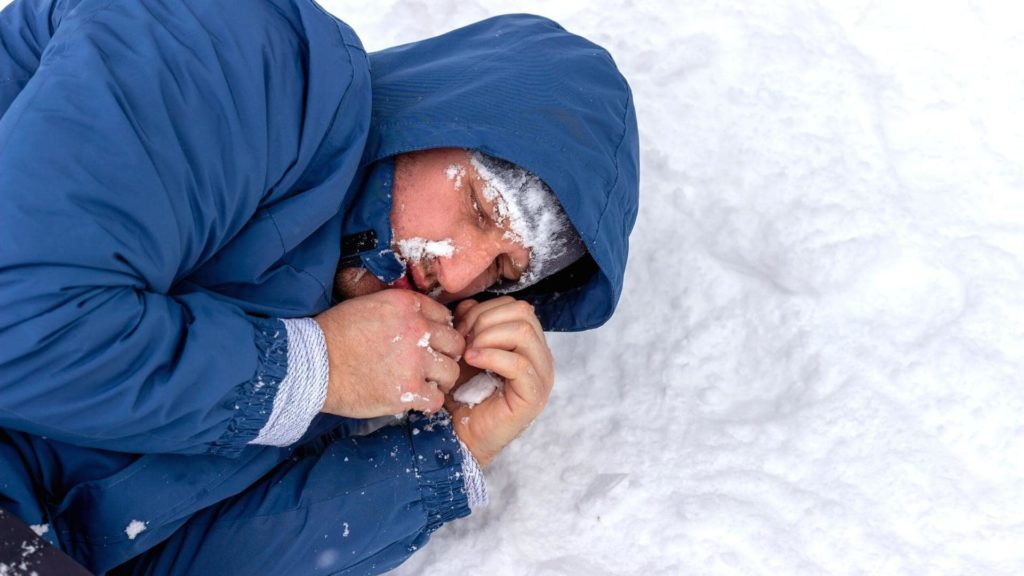
Frostbite – Some body areas are more susceptible to freezing temperatures than others. These include the ears, nose, chin, cheeks, fingers, and toes. Frostbite is caused when these body parts freeze because of extremely low temperatures. The body tissue in that part of the body could become permanently damaged, often leading to amputation. Frostbite is prominent in people with poor blood circulation, but also among people working in the cold who haven’t dressed appropriately.
Wearing protective coverings on all extremities when spending time in freezing outdoor temperatures is critical. The symptoms of frostbite include numbness, tingling, and hardened skin. The skin may also turn pale or blue with a waxy appearance.
First Aid measures include going to a warmer area, immersing the affected area in warm water (never hot water) or body heat. Keep the skin protected with loose dressings, elevate thawed extremities, stay hydrated and get medical attention.
Heat-Related Illnesses
Heat Exhaustion – Excessive sweating during heat exposure causes the body to lose fluids. Because of this, the body’s blood flows to the skin to eliminate heat. This causes a lack of blood flow to vital organs.The warning signs include sweating, dizziness, weakness, headaches, vomiting and more.
The best way to prevent heat exhaustion is to ensure your body remains cool. Stay hydrated and avoid exertive work during the hottest times of the day.
First Aid measures include placing the person into a cool area and giving them lots of liquids, especially water, clear liquids, or a sports drink to replenish the body’s lost minerals. Loosen clothing as much as possible and pour cool water on their torso. You can also cool them down by applying a cool cloth or ice to the neck, head, and face.

Heatstroke – Heatstroke is a severe environmental illness. The signs of heatstroke are an extremely high body temperature of 104F (40°C) and higher and loss of consciousness (partial or complete). Not all heatstroke victims sweat, so it is not a good indication. Other signs include severe headache, altered behaviour, rapid breathing, seizures, and dry/hot skin.
Precautions to prevent heatstroke include protecting against sunburn, wearing loose clothing, drinking plenty of fluids on hot days, and staying indoors during the hottest part of the day.
Treat heatstroke by removing the person from the heat. Loosen tight clothing and immerse them in cool water. Ensure their forearms and hands are in cool water. You may also place ice packs in the person’s armpits and chest. Fan them as a way to increase evaporation. If they are conscious, let them sip on a cool sports drink, coconut water, milk or water.
First Aid and Environmental Illness

First Aid training prepares you to treat victims of these and other environmental illnesses. At Coast2Coast, our Emergency and Standard First Aid courses are ideal, depending on the level of First Aid training you desire. This training is offered in a blended method to save you time and money. Pick your preferred location in the Greater Toronto Area, Western or Eastern Ontario, and register today.
